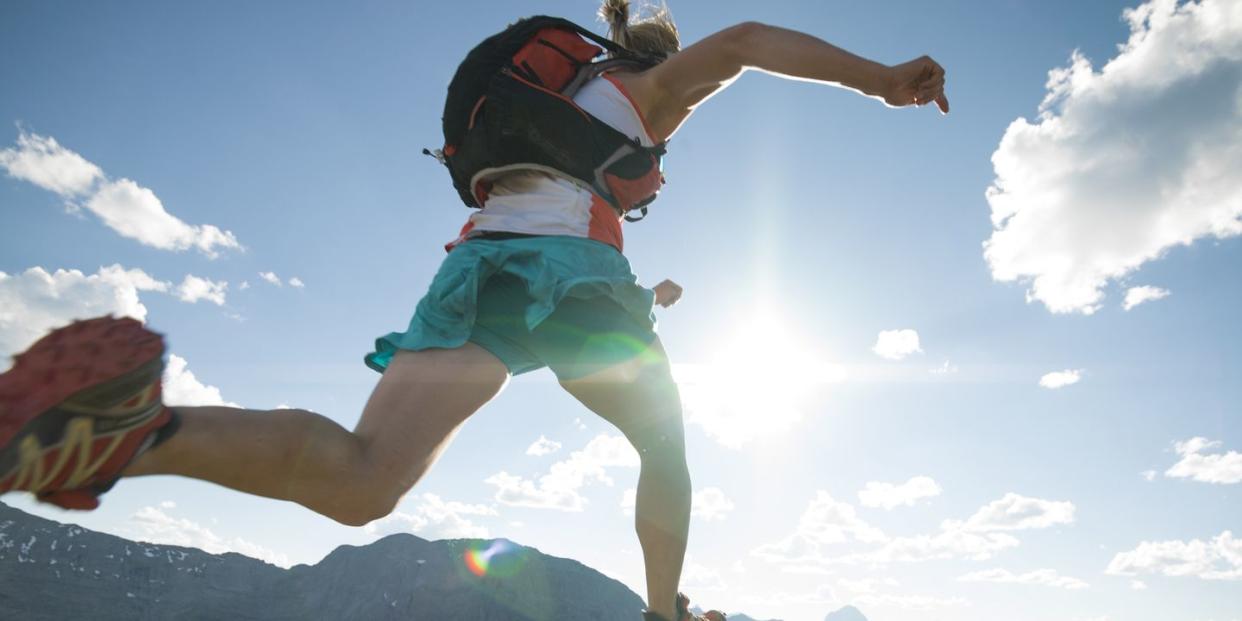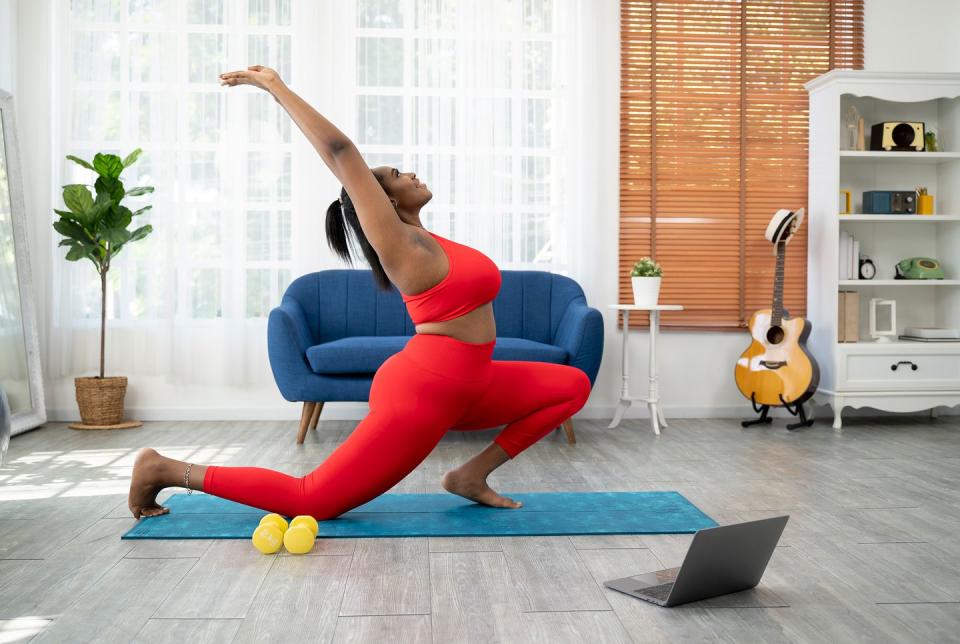7 ways to strengthen your kinetic chain and prevent injury

Your kinetic chain is essentially the interconnected network of muscles, ligaments, tendons and bones that make your body, from the top of your neck down to your toes. Kinetic literally means 'relating to, or resulting from motion' - so we are talking about the chain of movement that propels you forward.
If a human body takes a step forward, then moves to the side, and then jumps, you would see a fluid combination of biceps, quads, abs working together. That's the kinetic chain in action: each part of the body is a link, and each link depends on the one before it and after it for top performance. As you probably remember from primary school, 'The foot bone's connected to the leg bone, the leg bone's connected to the knee bone ... " and so on. Well, the kinectic chain is essential that, but on a grander scale.
So what happens when the links aren't strong, or one part has to over compensate for a weaker one? You guessed it: injury.
For instance, there's a direct connection between your foot mechanics and your knee position, so the way in which your foot strikes the ground can directly impact your knee. If you overpronate, rolling your foot to the inner side too much, this can impact you further up the chain. Likewise if you supinate, and your feet roll to the outer side. Some fortunate/well-trained athletes have a neutral footstrike, which is the healthiest for the rest of your body.
With overpronation, runners tend to put more stress on the inside of their shin – and so shin splints are often related to having a foot that rolls inward too much. Also, the most common knee pain, patellar-femoral (under the kneecap), often happens as the foot rolls inward too much. But here’s another kinetic chain reaction: this knee pain can also be caused by weak muscles in the hips and pelvis. The knee is being sandwiched between the ground and the hip. That’s the kinetic chain in action.
How to strengthen your kinetic chain and prevent injury
So how can you optimise your kinetic chain? Here are some of the best techniques.
Do some exercise every day

One of the best ways to strengthen your kinetic chain is by exercising every single day. Human bodies are designed for everyday use. Our ancestors, from the caves to the farm fields, got themselves out the door early and sweated all day, every day. We can certainly find 30 minutes to an hour to break a sweat. The key is to avoid overuse, so how do you do this?
Perform your central, sports-specific training however many times a week you need to in order to achieve your competitive goal. On the other days? Change it. Think of them as workout holiday days, but instead of lying around, do something for fun. You’ll see several terrific yet challenging options below. Try yoga for strength and flexibility, and Pilates for core strength. An ‘off day’ is a great time for a class. Some other suggestions: find a pool. Ride a bike. Play ultimate frisbee. Or maybe just walk your dog. The point is, a body that is used sensibly every day grows accustomed to being used and won’t be as prone to injury.
Condition your whole body
The ‘vanity muscles’ are something of a fitness joke when it comes to athletic performance. Big biceps and defined abs don’t do much for you, especially if you work them at the expense of the muscles around them. But if your biceps are trained in concert with your entire arm and shoulder? If your abs are part of a complete, well-conditioned core? Much better.
Total-body conditioning takes into account all the supporting muscles that are even more important to having proper kinetic chain function and remaining injury-free. The stronger the supporting muscles around each joint are, the less compressive force there is on the joint. Even if you have an arthritic knee, for example, if you strengthen around it, you’ll reduce the symptoms.
Here are two fast ways to add total-body training to your regime. First, whenever possible, add compound movements. Work as many muscles as possible in a single exercise. That means if you do a forward lunge, do it holding a medicine ball and add a core twist. And after that forward lunge? Do a reverse lunge and side lunges as well. Hit all directions.
Second, try individual single-leg exercises, such as single-leg squats, single-leg hops, single-leg lunges – exercises where you use your own bodyweight but also have to balance. That balancing act is huge. It gets all those small supporting muscles around the joints to fire up. Very quickly you’ll notice greater strength and stability around your ankles, knees and hips.
Do plyometrics and intervals
A good idea is adding in one or two total-body plyometric and interval running workouts
each week. Neither one requires a gym or any equipment.
Why do this? Muscles have two types of fibres, fast twitch (used for sprinting and explosive movement) and slow twitch (used for longer distance and endurance exercise). Even if you run long distances exclusively or have a passion for endurance events, you still need to maintain a balance between fast-and slow-twitch fibres. This gives you more athletic ability, prevents overuse injuries, and will keep your body from being a one-trick pony. Some examples of plyometric exercises are squat jumps, lunges, skater plyos (which mimic speed skating’s side-to-side motion) and compound movements like burpees.
For intervals, choose a time interval appropriate to your fitness level (anything from 10 secs on, 20 secs off to 60 secs on, 30 secs off – listen to your body) and apply it to your normal activity whether it's running, cycling, swimming, ect. For a taste of both, try a plyometric Tabata (20 secs effort, 10 secs rest) workout.
Do yoga and Pilates

Old-school static stretching – meaning that you don’t move while you do it, like when you hold a hamstring stretch for 30 secs – isn’t nearly as effective for total-body flexibility as regular yoga and Pilates movements are. These techniques deliver dynamic, movement-based flexibility and can transform your body. Pilates also hammers your core. You’ll feel more powerful, movement will be easier and more fluid, and importantly, you'll reduce your injury risk.
Test for running imbalance
How do you know if you have a muscle imbalance that might be affecting your form? Do a simple step-down test, once for each leg. To do this test at home, set up a box or stool or anything that lets you step down about 45cm. Set this up in front of a mirror and slowly step down to the floor. Watch those pelvic bones as you do it, or have someone with a good eye watch them for you. Do the step-down test once for each foot. If one hip sags, add in some single-leg exercises on that side (squats, lunges, hops) to help reestablish balance. Retest yourself every week until you've fixed the imbalance.
Get good sleep
This is a huge blind spot for so many people, but sleep is the most important activity of your day, no joke – especially if you're training hard or exercising every day. Sleep is the only time your body has to regenerate itself, rebuilding muscle, strengthening bone, restocking red blood cells and engaging in any number of other crucial processes that need time to take place. Not to mention REM sleep's importance in restoring your brain and helping you feel fresh in the morning rather than sluggish. Lack of sleep is tied to higher blood pressure, weight gain, elevated stress hormone levels and other things that will detract from not just your athletic performance but also your general health.
Don't forget to smile
Exercise, especially when you're training for a goal, can be such a dead-serious stretch of time. We forget it's meant to be fun. Get out there with some friends. Get intense if it ups your game, but at least enjoy the intensity. Exercise should be the most fun part of your day. No contest. What's more, when you're smiling you are more likely to be relaxed. And when you're relaxed, you are less likely to tense up your muscles, which in turns means you'll be less susceptible to pulls and strains.
This is an edited excerpt from The Athlete’s Book Of Home Remedies by Dr Jordan Metzl, published by Rodale and available from amazon.co.uk or penguinrandomhouse.com
You Might Also Like


